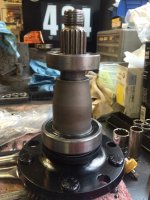So as part of my rear end rebuild I replaced all the rear wheel bearings (4)
Original bearings were open style that you pack with grease.
New bearings from BMW are sealed bearings.
So there is a spacer that goes inside the hub with a shim that you can order different thicknesses of.
This spacer I feel is designed for open packable bearing like original.
So again can I leave the item #6 & 7 out and not use at all?
Bearings are pressed in to internal stops and hub is secured with a nut so no way they can move around?
What does anyone else think?
Don, have you experienced this?

Can't seem to get list of parts to stay in format.
Original bearings were open style that you pack with grease.
New bearings from BMW are sealed bearings.
So there is a spacer that goes inside the hub with a shim that you can order different thicknesses of.
This spacer I feel is designed for open packable bearing like original.
So again can I leave the item #6 & 7 out and not use at all?
Bearings are pressed in to internal stops and hub is secured with a nut so no way they can move around?
What does anyone else think?
Don, have you experienced this?

Can't seem to get list of parts to stay in format.

